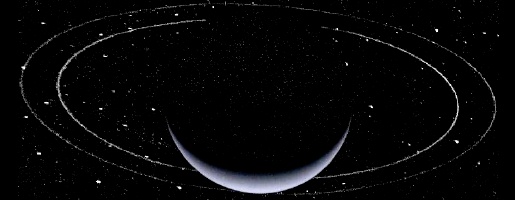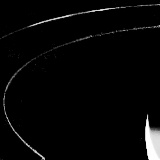 |
|||||||||||||||||||||
|
Voyager
image of Neptune's tenuous rings.
|
|||||||||||||||||||||
| THE RINGS OF NEPTUNE | |||||||||||||||||||||
| Neptune's rings were first observed from Earth. They were not observed directly, for they are too faint, but they do block starlight. Observations of stars being dimmed as the rings enter the line of sight demonstrated that the rings were made of clumps, and did not extend all the way around Neptune. | |||||||||||||||||||||
| The Voyager encounter with Neptune in 1989 revealed that the rings did indeed extend all the way around the planet - the clumps were just the thicker, brighter, parts of complete rings. | |||||||||||||||||||||
| The Four Rings | |||||||||||||||||||||
| Neptune has four main rings, named the Diffuse, Inner, Plateau, and Main, and they also carry the names of astronomers associated with the discovery of Neptune. The rings are quite dark, with a low albedo, and are described as sooty - they may even be red. Analysis of the light reflected by them indicates that they contain carbon compounds, though little else is known about their composition. | |||||||||||||||||||||
| A rough estimate of the particle sizes most common in the main ring is about 1 to 2 metres across. Dust particles are more abundant outside the rings. | |||||||||||||||||||||
 Three of Neptune's rings are visible in this Voyager composite image. |
|||||||||||||||||||||
|
|||||||||||||||||||||
| Main Ring | |||||||||||||||||||||
| Observations made from Earth show that the outermost, or Main, ring contains 5 arcs or ring segments. They range in length between 1000 and 10,000 kilometres and are located fairly close together, along a 45o arc of their orbital path. Three of the segments are particularly visible and are named Liberté, Equalité and Fraternité. Voyager 2 discovered that the ring arcs are bright sections of a faint but complete ring. | |||||||||||||||||||||
 The Main Ring has arcs called Liberté, Equalité and Fraternité. |
|
||||||||||||||||||||
| Plateau Ring | |||||||||||||||||||||
| Moving towards Neptune within the orbit of the Main ring is the more tenuous Plateau ring. The particles in the Plateau ring are about the same size as smoke particles. | |||||||||||||||||||||
| The Plateau ring has two dusty looking bands which are named Lassell and Arago orbiting either side of the path of the moon Galatea. Galatea seems to have cleared a path between them. Galatea and the ring have orbital periods that are in the exact ratio of 42:43. Another bright but narrow ring (the Inner ring) is met just outside the orbit of Despina . Despina is probably responsible for keeping the edge of the Inner ring crisp-looking and free of dust which would otherwise give it a fuzzy appearance. | |||||||||||||||||||||
 The orbits of Neptune's inner moons. |
|||||||||||||||||||||
| Diffuse Ring | |||||||||||||||||||||
| The innermost ring is called the Diffuse ring or the Galle ring, it is faint as well as narrow, and is therefore especially difficult to see. Some scientists suspect that the Diffuse ring may extend all the way down to the top of Neptune's atmosphere. | |||||||||||||||||||||
| Ring formation | |||||||||||||||||||||
| It is thought that the Main ring at least could have formed quite recently, perhaps as little as a few thousand years ago. The process begins with a collision, tidal break-up, or the disruption of a poorly consolidated body to put debris in orbit about Neptune. After a time, the clumpy sections of the ring ought to blend with the ring, dispersing along its length. As this has not yet happened, the debris arcs are thought to be relatively fresh. | |||||||||||||||||||||
| Another reason for assuming that the rings formed fairly recently is that the dust from the rings must be replenished. As it falls inwards towards Neptune it is gradually depleted. It must therefore have originated fairly recently. Alternatively the rings are supplemented in some way, perhaps by dust and particles broken from and blown off the moons by small meteorite impacts. It may turn out that the Main ring with its arc segments is not a young feature at all, as some scientists think the arcs are kept in place by the gravitational effect of Neptune's moon Galatea. | |||||||||||||||||||||
|
|
|||||||||||||||||||||
